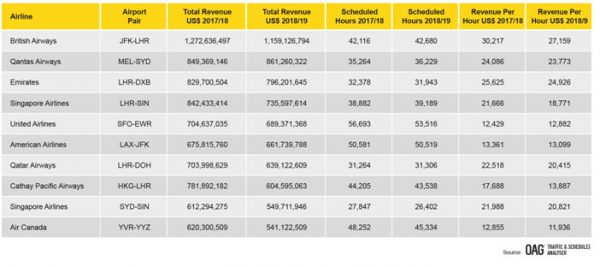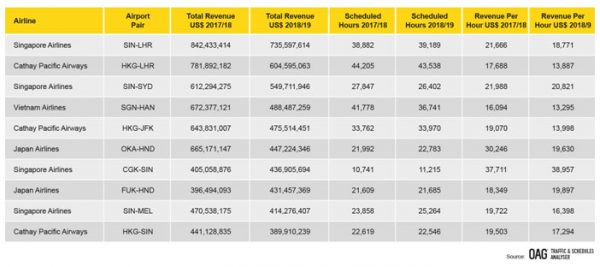SINGAPORE, 15 August 2019: Airlines count on a small selection of lucrative routes that prosper due to competitive advantage, market circumstances or limited competition.
“These are the routes that are protected at all costs,” says OAG blogger John Grant in a review of on world’s billion-dollar routes.
OAG analysed 2019 data and revenues to identify the highest revenue-generating routes worldwide for some of the world’s largest airlines. And which routes generate the highest revenue per hour.
British Airways’ Heathrow – JFK New York service retains its number one position with some USD1.15 billion of revenue, making it the only route to break that barrier.
The top 10 routes and airlines this year are unchanged but based on revenue per hour nine of the top routes have seen declines.
Just two Asian airlines, Singapore Airlines and Cathay Pacific, have top revenue earning routes that figure in the global ranking. SQ figures twice on the list due to the lucrative routes Singapore-London and Singapore-Sydney, while CX has its prized Hong Kong-London route.
Top 10 Highest Revenue Routes by Airline, April 2018 – March 2019

In Asia’s revenue ranking the Singapore – Jakarta route is number one per hours flown.
Despite rapid, low-cost airline growth in Asia the top 10 routes to and from Asia highlight how a scarcity of competing for capacity at some airports.
Disproving the theory that only long-haul flights can generate significant revenues the Singapore – Jakarta service of Singapore Airlines is the highest revenue producer in the world based on hours flow; generating nearly USD39,000 per hour flown; well ahead of routes such as Heathrow – JFK.
Increasing competition and emergence of low-cost airlines are clearly impacting on the revenue per hour for Japan Air Lines on the Tokyo Haneda – Okinawa service where the revenue has significantly declined year on year.
Asia, Top 10 Highest Revenue Routes by Airline, April 2018 – March 2019

OAG analysis suggests that there is unlikely to be any great movement either in or out of these tables in the next few years until capacity becomes available and then of course at both ends of the route.
(Source OAG: Extracts from blog written by John Grant)
For full report visit
https://www.oag.com/blog






